Darrell Brooks trial: Jurors view red SUV
Darrell Brooks trial: Witnesses track defendant after SUV ditched
The same day jurors saw the red SUV prosecutors say Darrell Brooks drove through the Waukesha Christmas Parade, witnesses testified about how they tracked Brooks' movements after he ditched the SUV and the DNA matches they found inside.
WAUKESHA, Wis. - Prosecutors called more witnesses Wednesday, Oct. 19 in the Darrell Brooks trial, charged in the November 2021 Waukesha Christmas parade attack. Mid-afternoon, the jury was taken out of the courtroom to view the red SUV. Video was provided later of that viewing.
The state called nine witnesses Wednesday, and most of the testimony focused on the red SUV.
2 jurors positive for COVID
Judge Jennifer Dorow started the day by informing the court that two jurors tested positive for COVID-19.
The first was excused on Monday. Dorow said she was notified about a second juror with the same health concern Wednesday.
Before polling each juror about health concerns, Dorow said the court had a new HVAC system with air purifiers and UV light system. Also, extra sanitation and masks were being provided, the judge said.
Darrell Brooks trial: COVID concerns about juror
A second juror raised COVID-19 concerns during the Darrell Brooks trial. It was addressed by the judge on Wednesday, Oct. 19.
When polled, none of the remaining jurors indicated any concerns related to COVID-19. The judge offered plexiglass panels be installed if jurors felt it was necessary. The jurors did not indicate that was necessary.
After the jury was excused from the courtroom, Brooks presented concerns about the jury, suggesting that each juror be tested for COVID-19. Judge Dorow said she would not mandate testing. She said she would also not mandate masks, noting none of the jurors were wearing them.
The judge told Brooks he had not been exposed, in her opinion, due to his distance from the jury.
Brooks asked the judge whether "it would be smart in the long run" to ensure the jury had not been compromised. Dorow said no one on the jury had indicated they had been compromised.
"I trust my jurors that they would report if they are not able to sit through the proceedings," said Dorow, noting that she would advise them again to do so.
"They indicated they are comfortable being there. I would trust them to report to me if anything changes," said Dorow.

Darrell Brooks
Discussion about Brooks' presence at jury viewing of red SUV
Also, prior to the jury being brought back into the courtroom, Judge Dorow said she wanted Brooks to be present for the jury viewing of the red SUV suspected of being used in the Waukesha Christmas parade attack. Brooks continued to question why the jury was even being presented this opportunity. The judge indicated it is a piece of evidence.
"Do you want to be present at the jury view?" asked the judge.
"I don't see the reason to be present for it," Brooks responded.
On Tuesday, Judge Dorow said she would require Brooks to be present, but the judge said overnight, she thought more about that decision and changed her mind.
"If that is your decision to not be present for that -- you have the right to be at that jury view," said Dorow.
Dorow noted there would be a recording of the jury viewing placed into the record "to make sure there is a record of what is done for this trial and any appellate purposes if need be."
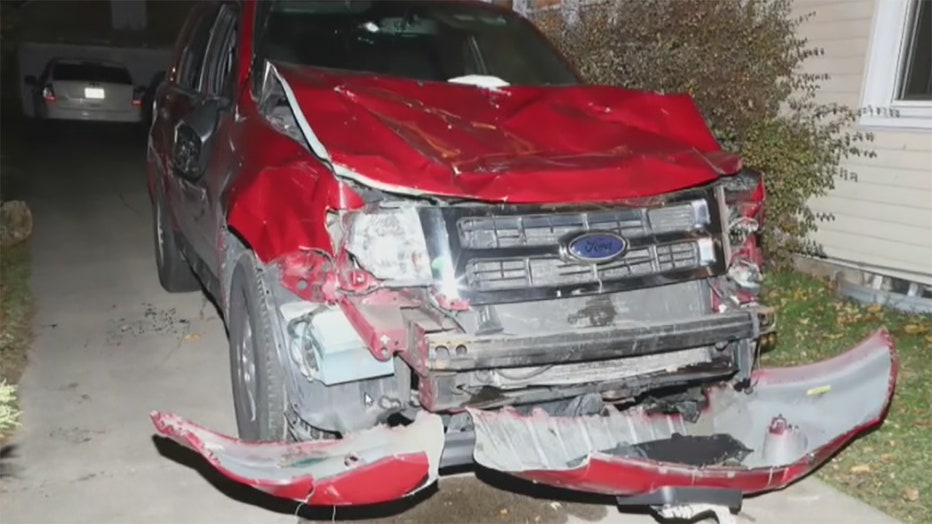
Red SUV left in Maple Road driveway after Waukesha Christmas parade attack
Brooks said he did not consent to being present for this jury viewing.
Brooks continued to press, asking why the jury viewing of the SUV would happen at all if he was not consenting to view it himself. The judge flatly stated, "Your lack of consent is not going to stop this jury view."
Brooks raised concerns regarding how he would be secured during the viewing, noting the shackles he wears in court. The judge said it would be up to the sheriff's department to secure him, but he would be secured in such a way where things like shackles would not be visible to the jury members. Dorow even told Brooks she would allow him to walk around the vehicle before the jury entered, noting that the jury members would be walking around the vehicle once.
Brooks asked whether he needed to sign a written waiver if he chose not to appear for this, and the judge said she was not going to require that.
Waukesha County District Attorney Sue Opper said this "jury view" was discussed with Brooks' former attorneys in August. She offered to have Brooks taken down to the red SUV during a break so he could see how things would go if he were to be present.
Before the jury was brought in, the judge noted a document filed by Brooks that included the heading: "Alleged defendant jurisdictional challenge and mandatory judicial notice by affidavit." She said she would take this under advisement.
Steven Schlomann, IT director at Waukesha School District
Steven Schlomann, IT director at Waukesha School District, was the first state witness to take the stand on Wednesday. Schlomann told the court there are roughly eight cameras on a school district property at 222 Maple. He said he was contacted by Waukesha police about the cameras and whether they had captured anything on the day of the Waukesha Christmas Parade.

Steven Schlomann, School District of Waukesha IT director
Schlomann testified the cameras on the school district property are able to record, and police requested him to look at specific times on that day of the parade. Schlomann said he found video that may be helpful to police and turned it over to them.
Robert Stone II, homeowner with security camera
Robert Stone II then testified for the state. He lives on Dunbar Avenue and has security cameras. Stone told the court he retrieved footage from those cameras following the Waukesha Christmas parade incident and turned it in to police.

Robert Stone II
On cross, Brooks asked if Stone saw anything unusual in his footage.
"I guess not, no," said Stone, adding that, "I was asked to go through my camera footage."
"Is it pretty much the same thing you’d see if you viewed it every day?" said Brooks.
"Sure," said Stone.
Andrew Amerson, homeowner with security camera
A third person with security camera access was next to testify for the state in the Brooks trial. Andrew Amerson lives on Dunbar Avenue and also has surveillance cameras.
"My cameras are evident from the street," Amerson said. "Police wanted to look at them."

Andrew Amerson
Leonard Miller, homeowner with security camera
Leonard Miller, another homeowner with a security camera, testified for the state. He lives on Central Avenue.
"I started looking through my cameras. I saw someone running up my driveway," Miller said.
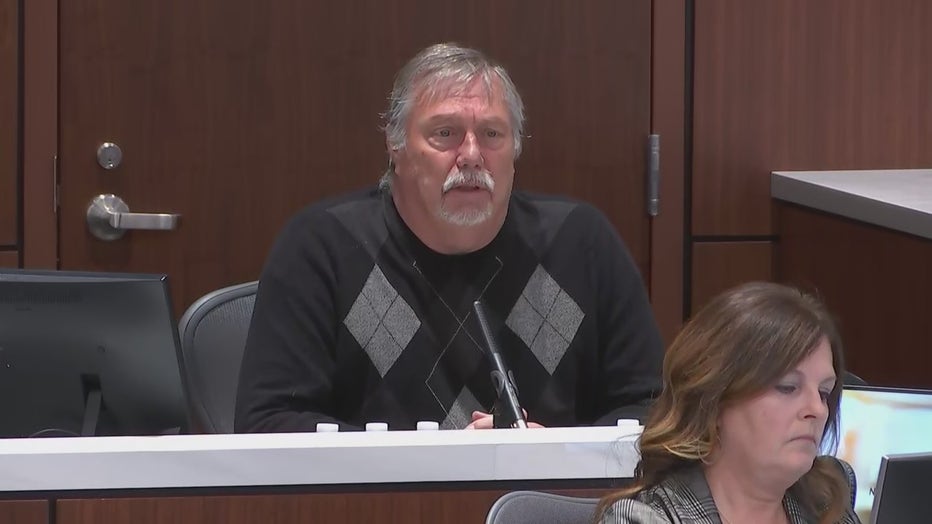
Leonard Miller
"Did you recognize them?" Opper asked.
"I did not," Miller replied.
Around 10:30 a.m. Wednesday, the court broke for a brief recess.
Kyle Becker, Waukesha Police Department
Next to take the stand for the state was Waukesha Police Officer Kyle Becker. Prosecutors indicated he was part of a search team canvassing the area immediately following the Waukesha Christmas parade incident.
Becker testified about the items that investigators located at a residence on Maple, including a blue sandal.
Darrell Brooks trial: Waukesha police officer testifies about evidence recovered
Waukesha Police Officer Kyle Becker testified about evidence recovered as part of the investigation after the Waukesha Christmas parade tragedy. The evidence included a sandal and sweatshirt believed to belong to Darrell Brooks.
"I thought Mr. Brooks lost the first sandal jumping the fence, "Becker said. "I located the gray hooded sweatshirt that Brooks was wearing in the parade, and in close proximity was the other sandal," said Becker.
Darrell Brooks trial: Defendant's cross-examination creates numerous objections
Darrell Brooks trial: Defendant's cross-examination creates numerous objections
On cross, Brooks asked Becker if items are "usually kept for this length of time.
"Yes. Until the investigation is complete," said Becker.
Jury views red SUV
Around 11:35 a.m., jury members were instructed they would get an opportunity to view the red SUV tied to this case, held in a secure garage as part of the court complex. The court went into recess at that point while the jury was gone.
Brooks trial; a look at the red SUV
Jurors in the trial of Darrell Brooks, the man accused in the Waukesha Christmas Parade attack, got the chance to see the red SUV that allegedly drove through. Here's a look at what the jury was allowed to see. (Courtesy: CourtTV)
NOTE: Despite earlier objections about going to view the red SUV with the jury, FOX6 News learned the defendant did, indeed, go to the jury view of the SUV.
There was no talking allowed during the viewing. Jurors were not allowed to take notebooks. The walls of the Waukesha County Jail garage were covered to avoid any chance of bias in front of the jury.
Justin Rowe, Waukesha Police Department detective
After the break, Justin Rowe, Waukesha Police Department detective, took the stand. He was tasked with going to the Maple Avenue area to search for items discarded by Darrell Brooks.
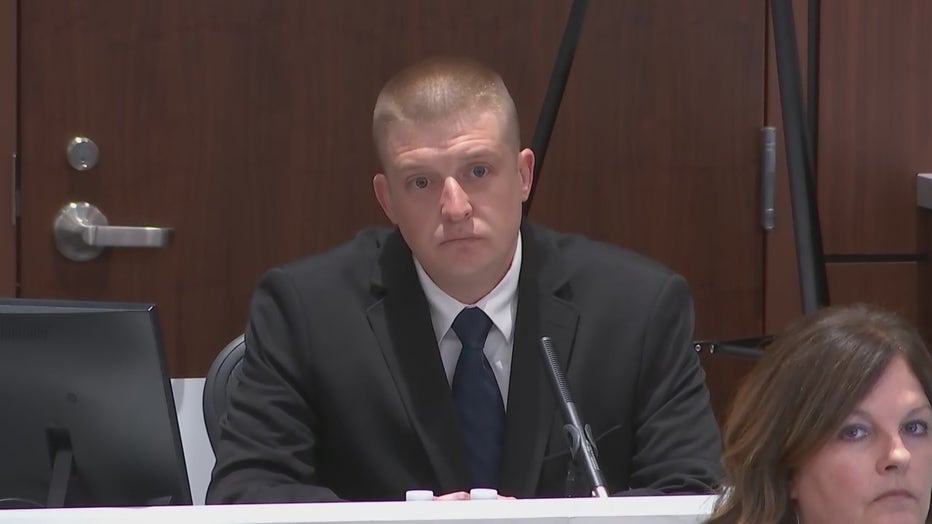
Justin Rowe
He said on Maple, they came across a sandal, and the other one was found a short distance from there, along with a gray sweatshirt.
Rowe testified he reviewed multiple surveillance video clips from the Waukesha School District and homeowners and was asked about anything of significance that he saw.
"There is a red blur near the bottom of the driveway. That’s Darrell Brooks, and you’ll see him cross the street," Rowe said of one video in particular.
Detective Rowe mapped Brooks’ path the night of the Waukesha Christmas Parade.

Rowe said the dashed red line in the map is the path Brooks took on foot. It shows Officer Salyers (who was off duty) in close proximity to where investigators say Brooks ditched the SUV.
Further south on the map, Rowe said Brooks stopped to try and get cellphones and "call an Uber." Prosecutors say Brooks was calling his mother.
The map and timeline show Officer Scholten fired shots at Brooks at 4:39 p.m. Nov. 21 as Brooks left the parade route. Brooks was arrested at 5:14 p.m.
Rowe said there are some areas they don’t have video of Brooks traveling.
On cross, Brooks asked how police know he crossed N. West Ave if there were no cameras or witnesses present.
"You were arrested on Elizabeth Street," said Rowe.
In other words, Brooks got across the street somehow.
Brooks also asked Rowe whether his report could have been tampered with in any way after he submitted it to the Waukesha Police Department.
Brooks asked Rowe if the State of Wisconsin is a "living, breathing human being." Opper objected, and under his breath, Brooks (again) muttered, "It seems like there’s no plaintiff."
Ryan Schultz, Wisconsin State Patrol
Next up for the state was Ryan Schultz, Wisconsin State Patrol mechanical inspector.
Schultz testified he looked at the SUV to see if there was anything wrong with it prior to the crash that would have contributed to it crashing.

Ryan Schultz
A 10-page crash reconstruction report was submitted by the state as an exhibit. Brooks became upset, noting this exhibit was not labeled for him, speaking under his breath. The judge had to inform the jury to disregard his statements.
Schultz testified it was requested to come to the State Crime Lab for inspections of the red SUV.
"The vehicle had quite a bit of front end damage, hood folded up in the air, there was quite a bit of debris stuck on it..." he said.
Schultz said the brakes on the SUV were in "good, working condition," and the brakes still "fully" functioned after the crash. He said the tires were "evenly worn."
He said there were no obstructions to the throttle pedal, which acted just as it should. The power steering system was also working properly.
He testified he did not open the hood of the vehicle because of the DNA evidence on it.
Schultz said when he ran the ignition, there were no diagnostic codes that came up. He said there were no recalls on this vehicle, only an extended service warranty from Ford that elapsed due to the vehicle’s mileage.
Schultz was asked if he observed anything that would have prevented the vehicle from stopping of the brake pedal was applied, and he said "no." Deputy District Attorney Lesli Boese followed up by asking whether he observed anything that would have contributed to the crashes the SUV was involved in. He said "no."
On Cross, Brooks asked Schultz whether he saw any bullet holes in the SUV, and he said, "There was more than one." He said he did not find any shell casings during his inspection of the SUV in December 2021.
Brooks asked whether anyone attempted to start the vehicle between the crash and his inspection, and Schultz said, "To my knowledge, no," but he did not know for sure.

Darrell Brooks in court on Oct. 19
Brooks then asked for clarity on his testimony regarding one of the tires on the vehicle, which was larger.
"One larger tire on the vehicle would obviously make the vehicle lean ever so slightly toward the tire that is larger than the others…" he said.
He said in this case, there was about three-quarters of an inch difference in height but said this wouldn't make much of a difference, just inflicting small wear and tear over time. Brooks asked if this would have created a "pull" on the vehicle, and Schultz said "no."
Brooks also questioned Schultz about the high beams on the SUV. The defendant also asked whether Schultz inspected the entire engine, and Schultz said "no." The witness said there was a coolant leak in that there was no coolant in the vehicle. Brooks questioned Schultz about a loose ball joint in the front left of the vehicle. Brooks asked how this would affect the vehicle, and Schultz said it would only wear down, eventually causing the wheel not to be able to steer, but the wheel on the red SUV was still steerable.
Schultz said there was difficulty starting the vehicle, referencing his testimony about gas.
Brooks also questioned Schultz about the report he wrote, and Schultz said the high-mount brake lamp was inoperable when he inspected it, meaning someone traveling behind the red SUV would not be able to see the brake light that's located on the hatch of the SUV. His report stated it was not known if this was working before the crash.
"I would have no way to tell when that light bulb went out," said Schultz.
On redirect, Boese referenced the high-mount lamp and asked whether the left brake light was working, and Schultz said the left stop lamp was working. Boese then asked about the ball joint and whether you can safely operate a vehicle if the ball and socket joint is not separated. Schultz said "yes," and he said the ball and socket were not separated on this vehicle.
Boese then asked if the engine controls acceleration, braking, steering or gear shifting. He said "no."
Boese then asked for clarification on what was leaking from the vehicle, if anything.
"Yes, so water pump, water coolant, it’s all interchangeable as far as the cooling system for the engine goes, and the cooling system was low at the time of the inspection and had been leaking, but from where, I don’t know," said Schultz.
Boese then asked if that controls the steering, the braking or the acceleration, and Schultz said "no."
Finally, Boese asked if the use of the high beams on the SUV would have been any assistance if the vehicle was coming up behind people, and Schultz said "no."
Judge Dorow admonishes Brooks: ‘I don’t find it funny'
Darrell Brooks trial: Judge admonishes defendant for frequent interruptions during testimony
Darrell Brooks trial: Judge admonishes defendant for frequent interruptions during testimony
After sending the jury off for a 15-minute afternoon break, the judge asked Brooks what he was referring to when he said, "That’s hilarious." Brooks said he was referring to the fact he saw some of the questions he asked were overruled, but the state could ask, and his objections were thrown to the side.
"I just think that’s funny," Brooks said.
"Well, sir, I don’t find it funny," Dorow said.
Dorow noted on April 22, the state filed a notice of expert naming Inspector Schultz as an expert witness and indicated he would testify consistent with his report. She said she directed his attention to statutes and rules of evidence dealing with expert testimony and that’s why she didn’t stop during testimony because the objection to not having an exhibit sticker on his report would not prevent the court from receiving the exhibit once the proper foundation was laid.
Dorow noted Brooks made disparaging remarks during the process.
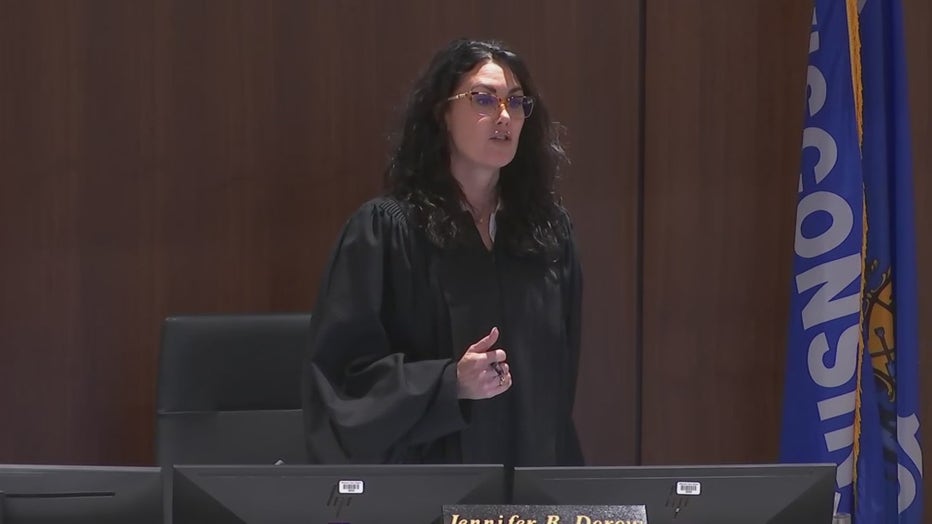
Judge Jennifer Dorow
Brooks said she was assuming incorrectly.
The judge said it was important he demonstrate courtesy and decorum through the proceedings.
Brooks asked whether the witness felt disrespected.
Dorow said she was not going to engage in the back-and-forth.
Brooks said her observations were incorrect and rolled his eyes.
Dorow said it’s her job to ensure the judge exercises reasonable control over the questioning of witnesses… avoids needless consumption of time, protects witnesses from harassment or undue embarrassment… and intervene when leading questions may be used to develop the witness’ testimony.
Boese said she took note of one of Brooks’ comments. His response was, "Stop trying to be slick."
"Yes, I did say that," said Brooks.
Brooks was still rambling as the court went into a 15-minute break.
Chris Johnson, Wisconsin State Crime Lab
Next up for the state after the afternoon break was Chris Johnson, chief of the Office of Crime scene response for the division of forensic sciences within the Wisconsin State Crime Lab. He testified that he has processed "several" vehicles that have been involved in fatal collisions with pedestrians.
He talked about how he was called out to Maple Street to process a vehicle abandoned in a driveway. He responded with a crime scene response photographer.

Chris Johnson
"It was reported to me that the vehicle was more than likely involved in running through the Waukesha Christmas Parade," said Johnson.

Red SUV on Maple Street

Red SUV on Maple Street
Waukesha County District Attorney Sue Opper then began showing Johnson photos of the vehicle.
When asked if there were plans to move the vehicle, Johnson described a "scene approach, scene assessment and scene processing strategy."

Red SUV on Maple Street
"My thought and my processing strategy this particular night was to collect anything that would be fragile in nature off of the vehicle and then get it transported to a more environmentally friendly facility to continue processing in the subsequent days," said Johnson.
As for the "fragile" items, Johnson described items in the yard of the nearby home, including some examination gloves and a winter hat, along with a headband around the driver door mirror of the SUV, which was broken. Johnson noted during transport, this item would have most likely fallen off.
He said the front bumper of the SUV had to be lifted up with bungee cords and resecured for the tow truck transport so that it would not be further damaged.
Johnson said from Maple Street, the SUV was taken to the Waukesha County Sheriff's Department's secure facility.
Johnson said the inside and outside of the vehicle were inspected.
"Based on my former experience, looking for surface types that might contain potential DNA evidence, so specifically, anything that’s in the vehicle that would have been handled to control the vehicle, or handled in a repetitive manner or with some kind of force," said Johnson.
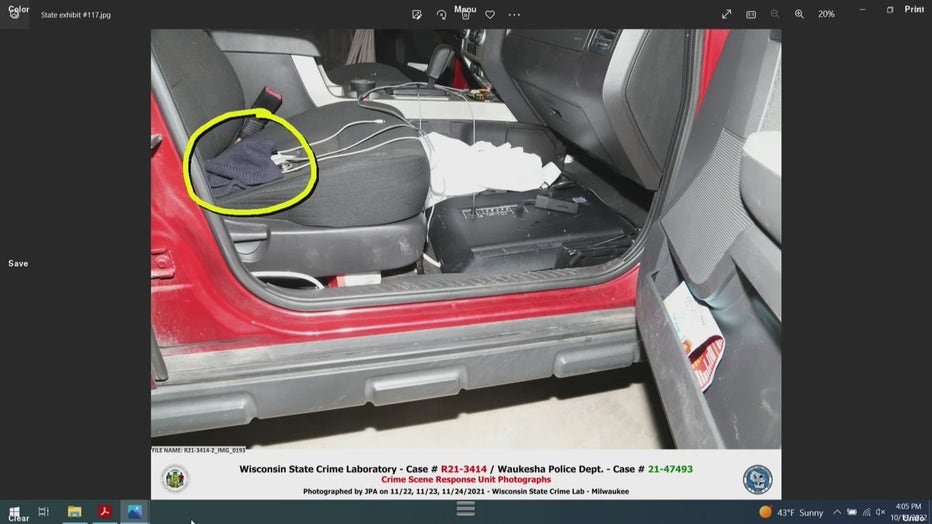
Red SUV
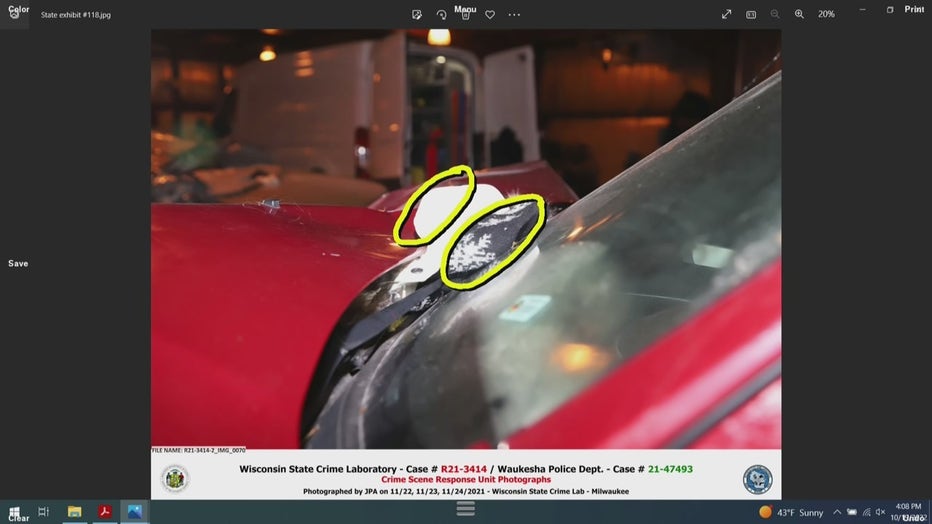
Red SUV
He said he found a hat on the front passenger seat cushion.
He said a detachable hood from a jacket and a winter hat were found pinned to the windshield by a windshield wiper arm and the "crumpled hood."
He said there was paperwork inside the vehicle that had the name "Darrell E. Brooks" on it.
Brooks admonished again for ‘constant mumbling, interruptions’
Darrell Brooks trial: Defendant, judge spar over questioning of witnesses
Darrell Brooks trial: Defendant, judge spar over questioning of witnesses
The judge excused the jury for a legal discussion, and Brooks nearly got removed to the adjacent courtroom due to his interruptions. Brooks was upset after it was noted that Opper placed some evidence on the table for Johnson, the witness.
"Whoa, whoa, whoa, whoa. On the table? How did it get on the table?" Brooks asked.
"You are well aware the court made some pre-trial rulings related to whether the parties could approach the witness stand, and I did that because you’re in custody, and I’m not going to allow you to approach the witness stand while in custody. That is why various precautions have taken place to limit that from happening…" said Dorow. "We’ve had bailiffs take items up to the witness stand, or items have been given to the witnesses, or they’ve been placed on the witness stand. That’s proper… No one is pulling a fast one on you. No one is doing something that is prohibited by this court… Frankly, from my perspective sir, your comments are an attempt to dig in at this jury to somehow create doubt about this case or the fairness of these proceedings…"
"I’ve taken the jury out at this point to admonish you that any further mumbling under your breath or not recognizing when I uphold or sustain an objection…. I’m not holding you in contempt. I’m well aware that that’s one of my options…" Dorow added.
Dorow gave Brooks a warning.

Judge Jennifer Dorow
"Do not interrupt again. If this jury comes back or when they come back and you do that, then you will be removed, and you will forfeit your right to be present for the examination of this witness," said Dorow.
Brooks responded by saying, "You might as well remove me then." Brooks told the judge she did not know what he was trying to do.
"You’re making a record of me trying to look bad. It’s not going to work!" said Brooks.
As Brooks yelled, Dorow advised Brooks to be respectful.
"Don’t nobody tell me what to do. I don’t tell nobody else what to do. I’ve never told you to do anything at all," said Brooks. "I’m a grown man with grown kids. Don’t nobody talk to me like that. Nobody."

Red SUV

Red SUV
With the jury back in the courtroom, Johnson was shown photos of a bullet hole in the windshield. He testified it likely shattered the back right window and then went through the windshield.
He then described the process of swabbing the steering wheel and gear shift for DNA. He noted that clothing items worn by an individual, such as the hat on the passenger seat, are a really good source of DNA.
Brooks began his cross-examination of Johnson by asking about the DNA analysis. Brooks specifically asked if Johnson, who did not perform the DNA analysis, knew the results. Johnson said he spoke with the investigator who performed the DNA analysis, but he said "I don't know the exact results, no."
The witness was asked by Brooks about the headband on the vehicle and how it got there. Johnson said it likely got there when the vehicle came into contact with something or someone who was wearing it. Brooks asked if he knew that for sure, and he said "no."
Brooks asked questions about the securing of the bumper for transport and why the SUV was taken from the scene.
"It’s easier to do examinations in a controlled environment," said Johnson.
Brooks asked about the hat that was found in the backyard and whether it had any relevance to the vehicle.
"It was an item of evidence or potential item of evidence that just seemed out of place, so in those types of situations, I always collect those types of items," said Johnson.
Johnson was asked about the photos shown during his testimony, which he said were taken over multiple days. He said the examination of the vehicle itself took "probably over 40 hours," not including the report he wrote, which was a summary of his inspection.
"The vehicle needed a comprehensive evaluation, processing, examination of pretty much every side and surface of that vehicle," said Johnson.
On redirect, Opper asked what Johnson meant when he said the vehicle was secured when he arrived on Maple Street.
"The perimeter was secured with crime scene tape, and there were officers that were standing at the location where the vehicle was," said Johnson.
He said anyone that would have come up to the vehicle would have been stopped by law enforcement.
Trevor Naleid, senior forensic analyst
The state's last witness Wednesday was Trevor Naleid, Wisconsin Department of Justice State Crime Lab senior forensic scientist in the DNA analysis unit.

Trevor Naleid
Naleid testified he has worked with DNA samples about 175 times during his training. He said he has worked just over 500 forensic DNA cases, and he has processed over 2,000 DNA samples.
Naleid said he developed DNA profiles from the swabs of the steering wheel of the SUV.
"It was a two-person mixture with at least one male," said Naleid, adding that he was able to identify those people using software.
Naleid was questioned about the software, and he said it had been accepted in Wisconsin courts more than 100 times since it was brought online in January 2020.
After analyzing the two-person finding on the steering wheel with the software, Naleid said, "Based on it being a two-person mixture, Erika Patterson and Darrell Brooks are both very strong support for inclusion."
He said the swab of the gear shift was a three-person mixture with at least one male contributor. The software result was "the same as the steering wheel."
"So Erika Patterson and Darrell Brooks are both very strong support for inclusion," said Naleid.
In layman's terms, Naleid said it was at least one quadrillion times more likely the DNA was from Brooks/Patterson (and someone else for the gear shift) versus three random people.

Trevor Naleid
As for the hat that was found in the SUV, Naleid said it was a two-person mixture with at least one male contributor.
"Erika Patterson has a very strong support for exclusion. Darrell Brooks has strong support for exclusion. Wilhelm Hospel (Milwaukee Dancing Grannies volunteer killed in the parade attack) has very strong support for inclusion. He is above that one quadrillion threshold that we have," said Naleid.
A sweatshirt was also analyzed. He said a reddish brown stain on the right sleeve tested presumptive positive for blood. Five hairs were also retrieved. Naleid said the DNA was a three-person mixture with at least one male contributor, with the same mixture on the cuff links. The stain was a two-person mixture with at least one male.
Using the software, Naleid said as to the collar and the cuffs, "Mr. Brooks has very strong support for inclusion." As to the stain, "Both Erika Patterson and Darrell Brooks have very strong support for inclusion."
On cross, Brooks asked for clarification on what Naleid meant when he said DNA "mixture."
"A mixture just means that it is more than one person present in the profile," said Naleid.
Brooks questioned Naleid about why it took so long for his analysis to be completed. The witness noted the evidentiary items weren't received until January, and he completed his report in April. Naleid said he generated 583 pages, and his final report was 15.
Brooks also questioned the witness about the process of obtaining the evidentiary items and where they went after he was done with them. Naleid said they were unsealed when he began his analysis, and they were returned to the evidence technician and put back into storage when he was done.
Brooks asked about the "three-person mixtures" and questioned whether there is DNA that was found that is still unknown.
"That's correct," said Naleid.
On redirect, Opper asked about the source of the hairs on the sweatshirt. Naleid said Darrell Brooks was the source.
Brooks expected to call witnesses Thursday
Jury instructions were read to the jury shortly before 6 p.m.
The judge ordered court to begin at 9 a.m. Thursday, and she said she would decide in the morning whether Detective Casey, who previously testified, could be recalled by the state for further questioning.
That would be the state's last witness.
Opper also indicated she would have a motion Wednesday morning.
Brooks noted he had completed the requested order of his witnesses. He said he organized the witnesses by threes, guessing the first three would be Thursday morning, the next three Thursday afternoon/evening, the next three Friday morning and the next three Friday afternoon/evening.
As of Wednesday evening, Brooks stated he was not sure whether he would be testifying himself.
Christmas parade attack
Prosecutors say Brooks drove a red SUV through the parade route on Nov. 21, 2021, killing six and injuring more than 60 others.
On Nov. 21, 2021, according to prosecutors, Brooks met up with his ex-girlfriend in Frame Park, the same woman he is accused of running over with his red SUV earlier in November 2021. She told police they argued in his SUV before he started driving, and he "was driving around with one hand and striking her in the face with his other hand." She eventually got out and called her friends for help.

Waukesha parade attack victims identified
Soon after that, according to prosecutors, Brooks drove that red SUV through the parade route, killing Jackson Sparks, 8, Virginia Sorenson, 79, LeAnna Owen, 71, Tamara Durand, 52, Jane Kulich, 52 and Wilhelm Hospel, 81. More than 60 others were hurt.

